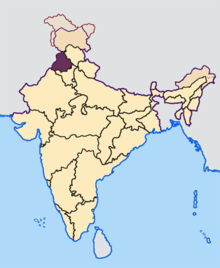Demographics of Punjab, India
| Population Growth | |||
|---|---|---|---|
| Census | Pop. | %± | |
| 1951 | 9,161,000 | — | |
| 1961 | 11,135,000 | 21.5% | |
| 1971 | 13,551,000 | 21.7% | |
| 1981 | 16,788,915 | 23.9% | |
| 1991 | 20,281,969 | 20.8% | |
| 2001 | 24,289,296 | 19.8% | |
| source:Census of India [1][2] | |||
Sikhism is the most practiced faith in Punjab, and roughly 60% of the population belongs to the Sikh faith. 37% of the population practices Hinduism. Other faiths include Islam, Buddhism, Christianity and Jainism.[3]
The holiest of Sikh Shrines, the Harmandir Sahib (or Golden Temple), is in The Holy city of Amritsar. The Akal Takht which resides within the Golden temple complex is the temporal seat of Sikhs. Of the five Takhts[Temporal Seat] of Sikhism, three are in Punjab. Anandpur Sahib is where Guru Gobind Singh created the Khalsa on Vaisakhi. During major holidays on the Sikh calendar (such as Vaisakhi, Hola Mohalla, Gurpurb or Diwali), many Sikhs gather and march through virtually every city, town and village in Punjab. Sikhism is so common in fact, that at least one Sikh Gurdwara can be found in every village, town and city (in various styles and sizes).
The Punjabi language, written in the Gurmukhi script is the official language of the state. Muslims form slight majority in the Malerkotla town. The Muslim population in Punjab has increased to 1.57% due to labourer workers from other Indian states, mainly Bihar and Uttar Pradesh.
| Religion | No. of people[3] | % of total |
|---|---|---|
| Total population | 24,272,486[4] | 100% |
| Sikhs | 14,592,387 | 60% |
| Hindus | 8,997,942 | 37% |
| Muslims | 382,045 | 1.6% |
| Christians | 292,800 | 1.2% |
| Buddhists | 41,487 | 0.17% |
| Jains | 39,276 | 0.16% |
| Others | 8,594 | 0.04% |
Religion Population by District
At the 2001 census[5]
| District | Sikhs | Hindus | Christians | Muslims |
|---|---|---|---|---|
| Gurdaspur | 44% | 47% | 7% | 0.987% |
| Amritsar | 77% | 21% | 2% | 0.232% |
| Kapurthala | 59% | 38% | 0.849% | |
| Tarn Taran | 90% | 10% | ||
| Jalandhar | 37.7% | 59% | 1% | 0.882% |
| Hoshiarpur | 40% | 59% | 1.040% | |
| Nawanshahar | 40% | 60% | 0.691% | |
| Ludhiana | 49% | 47% | 2% | 1.72% |
| Moga | 54% | 43% | 3% | 0.67% |
| Bathinda | 74% | 25% | 0.832% | |
| Faridkot | 60% | 40% | 0.316% | |
| Firozpur | 51% | 47% | 1% | 0.193% |
| Mansa | 78% | 20% | 0.849% | |
| Sangrur | 70% | 22% | 7.89% | |
| Muktsar | 74% | 25% | 0.34% | |
| Fatehgarh Sahib | 75% | 23% | 2.37% | |
| Patiala | 56% | 42% | 1% | 1.88% |
| Chandigarh | 16% | 79% | 1% | 3.97% |
| Rupnagar | 57% | 41% | 2.025% |
Christians make up about 1.1% of the population mainly concentrated in Gurdaspur. Muslims make up close to 1.57% residing mainly in Malerkotla, Sangrur, Chandigarh and Qadian. The Punjab government have also built NRI Police stations in cities such as Jalandhar, Nawanshahr, Ludhiana, Moga, and Hoshiarpur for the protection of non resident Indians who come to visit their motherland, and oversee their property.
References
- ↑ "Demographic Trends". Census of India. www.punenvis.nic.in. Retrieved 2008-06-04.
- ↑ "Census Population" (PDF). Census of India. Ministry of Finance India. Retrieved 2008-12-18.
- ↑ 3.0 3.1 Census of India, 2001: population of Punjab by religion
- ↑ Census of India, 2001
- ↑ Basic 2001 census data by state and district
| |||||||||||||||||||||||||
